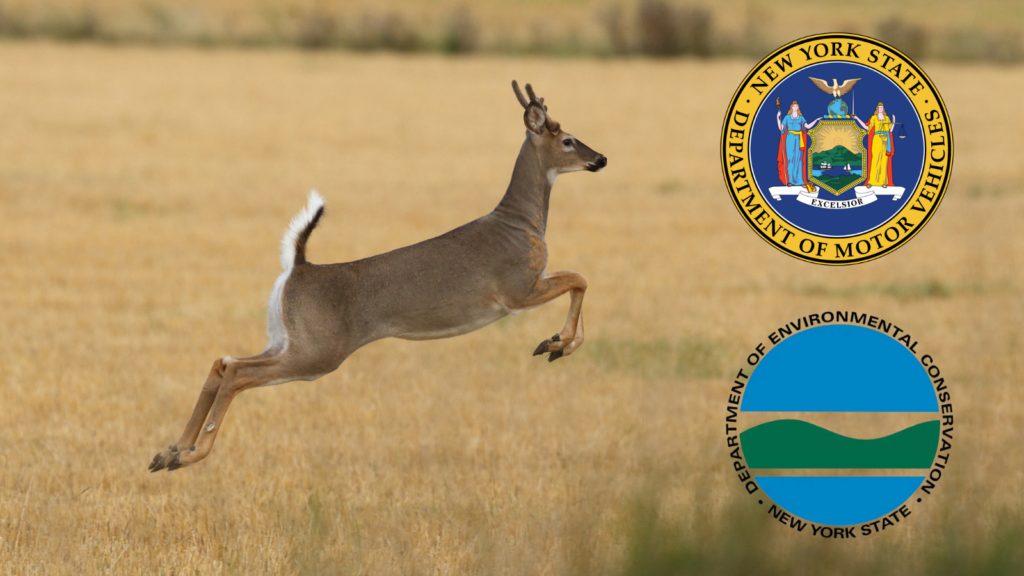
The New York State Department of Environmental Conservation (DEC) and Department of Motor Vehicles (DMV) today reminded drivers to be aware that deer and moose are most active and more likely to enter public roadways this time of year, as they search for mates during their breeding season, which is the months of October, November and December.
According to the University at Albany’s Institute for Traffic Safety Management and Research, in 2022, 41.5 percent of the crashes between deer and vehicles occurred during this three-month span.
Motorists should also be on alert for moose on roadways in the Adirondacks and surrounding areas this time of year.
“Fall is the time of year wildlife activity across New York State is most prevalent, especially for deer or moose crossing roadways and creating the potential for an accident,” said DEC Commissioner Basil Seggos. “Regardless of where you live in New York State, motorists should be on the lookout for wildlife that may cross their paths and follow key safety tips to avoid animal encounters while on the road.”
“Fall is a wonderful time to drive around New York State to enjoy the beautiful colors as the leaves change, but it is also a time to keep a careful watch for animals in the roadway,” said Mark J.F. Schroeder, DMV Commissioner and Chair of the Governor’s Traffic Safety Committee. “You should watch for deer-crossing signs and for animals at the side of the road that may suddenly dart into traffic.”
Motorists should be aware animals are especially active at dawn and dusk, when visibility may be reduced and commuter traffic may be heavy. DEC recommends motorists take these precautions to reduce the chance of hitting a deer or moose:
- Decrease speed when you approach deer near roadsides. Deer can “bolt” or change direction at the last minute;
- If you see a deer go across the road, decrease speed. Deer often travel in groups, so expect other deer to follow;
- Use emergency lights or a headlight signal to warn other drivers when deer are seen on or near the road;
- When a deer or moose is seen approaching the roadway ahead, honk your car horn to help them avoid entering the roadway;
- Use added caution on roadways marked with deer crossing signs; and
- Use extreme caution when driving at dawn or dusk, when animal movement is at its highest and visibility is reduced.
If encountering an animal on the roadway, brake firmly but do not swerve. Swerving can cause a collision with another vehicle, a tree, a pole or other objects. If an animal is hit, DEC advises motorists to stay away from the animal. A frightened, wounded deer or moose could use its powerful legs and sharp hooves to cause harm.
Other tips for if you strike or encounter an animal:
- Move your vehicle to a safe place. If possible, pull over to the side of the road, and turn on hazard lights. If leaving the vehicle, stay off the road and out of the way of any oncoming vehicles. If a collision occurs at dusk or dawn, please remember traffic visibility could be reduced.
- Call the police. Alert authorities if the animal is blocking traffic and creating a threat for other drivers. If the collision results in injury, death, or more than $1,000 in property damage, you must fill out an official crash report (PDF) (leaves DEC’s website) and send it to DMV.
- Don’t assume your vehicle is safe to drive. Look for leaking fluid, loose parts, tire damage, broken lights, a hood that won’t latch and other safety hazards. If your vehicle seems unsafe in any way, call for a tow truck.
Early fall is the breeding season for moose in northern New York, and moose wander looking for mates, leading them to areas where they are not typically seen. While this improves the opportunities for people to enjoy moose sightings, it also increases the danger of colliding with one on the roadway.
Moose are much larger and taller than deer, and their large size can result in significant damage in the event of a vehicle collision. Moose are especially difficult to see at night because of their dark brown to black coloring and their height – which puts their head and much of their body above vehicle headlights.
More information about moose and deer can be found on DEC’s website. Additionally, precautions and safety tips about special driving conditions (leaves DEC’s website), such as driving in rain, in winter, or in driving emergencies, can be found on DMV’s website.


